Yellow Flowering Vines (with Pictures): Identification Guide
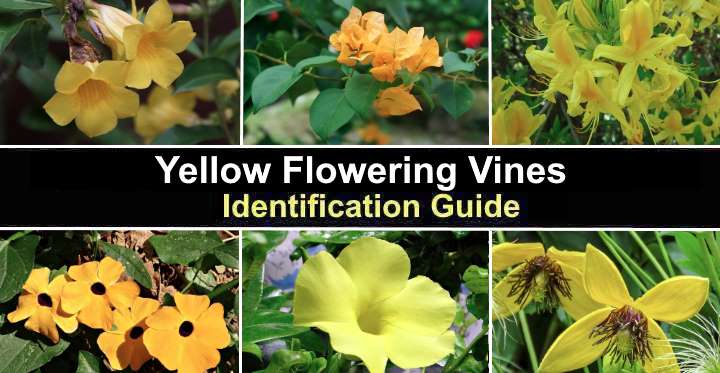
Yellow flowering vines can add a bright and cheerful touch to any garden or landscape. These climbing plants with yellow blooms can scramble over trellises, fences, or arbors, creating a stunning vertical display. Some popular vines with yellow flowers look spectacular, cascading over walls, covering the ground, or growing in hanging baskets.
Yellow-flowering vines provide beautiful flowers and attract pollinators such as bees and butterflies to garden landscapes. Whether you want to add a splash of color to a dull wall or create a vibrant entrance, yellow flowering vines are a great choice.
This article showcases various yellow flowering vines that can add a pop of color to your garden. Descriptions and pictures of the vines will help you choose the best ones to enhance your landscape with their vibrant yellow blooms.
What Are Yellow Flowering Vines?
Vining plants with yellow flowers are versatile, climbing plants typically with long, flexible stems. They can twine, cling, or use tendrils to support themselves as they grow upward or sprawl along the ground. Many ornamental flowering vines thrive in full sun; however, some grow better in partial shade.
Some popular yellow flowering vines include trumpet vine, black-eyed Susan, yellow honeysuckle, and yellow jasmine.
Yellow-flowering vines are ideal for front or backyards. The bright yellow, golden-yellow, or lemon-colored blooms brighten yards with their vibrant colors. Their dense evergreen or deciduous foliage contrasting with the yellow flowers also provides beauty, natural shade, and privacy when growing on fences, trellises, and arbors.
Types of Yellow Flowering Vines (with Pictures): Identification Guide
Let’s look in more detail at the most common types of yellow-flowering vines that are excellent landscaping options for front or backyards.
Golden Trumpet (Allamanda cathartica)

Golden trumpet is an evergreen climbing vine with vibrant trumpet-shaped yellow flowers. The shrubby vine is identified by its glossy, leathery leaves, fragrant yellow blossoms, and brown woody stems. Grown as a vine, this evergreen plant grows 20 ft. (6 m) tall and spreads 6 ft. (1.8 m) wide.
Golden trumpet vine doesn’t have tendrils or twines. Therefore, it needs support if you want to add a vertical accent over a fence, trellis, pergola, or arbor. This low-maintenance vine can brighten your porch, patio, deck, or balcony. The vigorous, fast-growing vine thrives in warm temperatures.
Golden trumpet vines benefit from pruning to control their size and shape. Prune them in late winter or early spring before new growth begins. Remove any dead or damaged branches and trim back overly long stems to encourage bushier growth. Be mindful of their growth pattern and provide support for vertical growth if needed.
The Golden trumpet’s bright golden yellow flowers are beautiful, contrasting with the bright green foliage. Landscaping ideas for the yellow-flowering vine include a fence or trellis cover, a container plant, or trimmed as a shrub with yellow flowers.
Golden trumpet vines appreciate organically rich, fertile soil. Composting can help improve the soil’s fertility and provide the necessary nutrients for robust growth and vibrant yellow flowers.
- USDA Hardiness Zone: 10 to 11
- Light Exposure: Full sun
- Flowering season: Throughout summer until first frost
- Size: 10 to 20 ft. (3 – 6 m) tall and 3 to 6 ft. (1 – 1.8 m) wide
- Soil and Water Requirements: Organically rich, fertile, well-drained soils
Winter Jasmine (Jasminum nudiflorum)
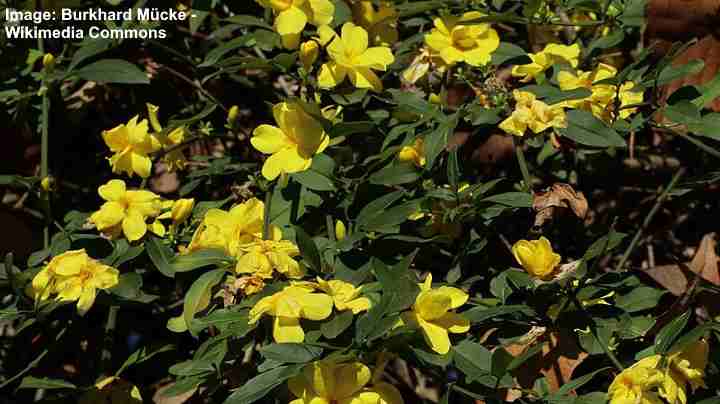
Winter jasmine is an eye-catching deciduous shrub that adds a burst of bright lemon-yellow color to winter landscapes. Identifying characteristics of the vining shrub are its star-shaped yellow flowers, red buds, trifoliate leaves, and willow-like green stems. Winter jasmine also has long, arching branches that vine up to 15 ft. (4.5 m) long.
What sets this vine apart is not just its visual appeal but also its sweet and delightful fragrance. Early blooming winter Jasmine is ideal for adding warm, vibrant colors to late winter landscapes. The yellow flowers on the long, vining stems look spectacular, cascading over a retaining wall, fence, or yellow-flowering ground cover. You can also grow it as a mounding shrub with yellow flowers.
Winter jasmine is best pruned after it has finished flowering, typically in late winter or early spring. Pruning should focus on removing dead or straggly growth and shaping the plant. You can also cut back some of the longer stems to maintain a tidy appearance.
- USDA Hardiness Zone: 6 to 9
- Light Exposure: Full sun or partial shade
- Flowering Season: Late winter or early spring
- Size: 4 to 15 ft. (1.2 – 4.5 m) tall and 3 to 6 ft. (1 – 1.8 m) wide
- Soil and Water Requirements: Well-draining, loamy soil
Yellow Jessamine (Gelsemium sempervirens)
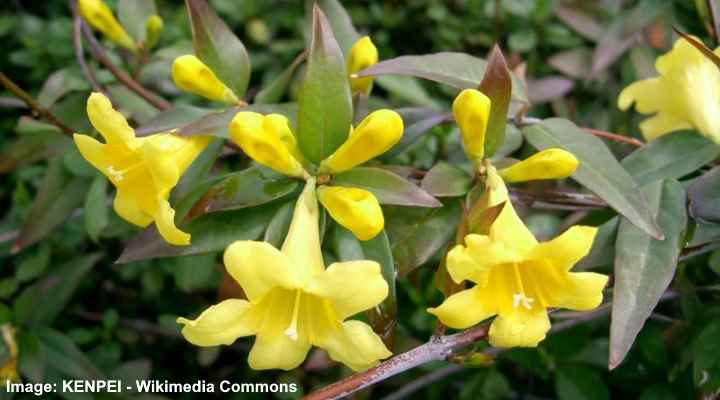
Yellow jessamine is a vining evergreen climbing plant with clusters of beautiful canary-yellow funnel-like flowers. Native to the southeastern United States, this yellow-flowering climber boasts dense foliage, showy clusters of sweet, fragrant blossoms, and a scrambling habit. The trumpet-shaped yellow flowers add a pop of color to the landscape in late winter and early spring.
Yellow jessamine, also known as Carolina yellow jessamine, is the official state flower of South Carolina. This yellow flowering vine twines and climbs over fences, trellises, garden structures, or arbors. Its versatility shines as it thrives as a ground-hugging plant, creating carpet-like ground cover. This sun and heat-loving plant also grows in cooler climates as a trailing plant in hanging baskets where you can bring it indoors in the winter.
Yellow Jessamine is native to the southeastern United States, but it also thrives in certain parts of the central United States.
- USDA Hardiness Zone: 7 to 10
- Light Exposure: Full sun to partial shade
- Flowering Season: Late winter to late spring
- Size: 10 to 20 ft. (3 – 6 m) tall and 3 to 6 ft. (1 – 1.8 m) wide
- Soil and Water Requirements: Well-drained, organically rich soil, and it’s drought-tolerant once established
Black-Eyed Susan Vine (Thunbergia alata)

Black-eyed Susan vine is a twinging climbing vine with vibrant yellow or orange flowers with purple-black centers. The evergreen vine features heart-shaped dark green leaves, five-petalled yellow flowers, and fast growth. The vigorous vine grows throughout the year in tropical landscapes and can reach heights up to 8 ft. (2.4 m) tall.
Black-eyed Susan twining vines are excellent yard landscape solutions for their fast growth, brightly colored lemon-colored flowers, and lush, dense foliage. The flowers can quickly cover trellises, unsightly fences, ugly garden structures, or arbors with beautiful blooms.
You can enjoy the vine’s yellow or orange flowers in containers or hanging baskets in cooler climates. Due to its rapid growth, you can also grow it as an annual twining vine.
Black-eyed Susan vines are fast growers and benefit from regular pruning to keep them in check. You can prune them throughout the growing season as needed, cutting back excessive growth or removing spent flowers to encourage continuous blooming.
- USDA Hardiness Zone: 10 and 11
- Light Exposure: Full sun or partial sun
- Flowering Season: From summer through fall and until the first hard frost
- Size: 3 to 8 ft. (1 – 2.4 m) tall and 3 to 6 ft. (1 – 1.8 m) wide
- Soil and Water Requirements: Well-drained, organically rich soil with medium moisture
Trailing Lantana (Lantana montevidensis)

Trailing lantana is a low-growing, sprawling, shrubby plant with purple or yellow flowers. The identifying features of this tropical spreading plant are its aromatic ovate, dark green leaves, clusters of tiny tubular lilac or yellow blooms, and long blooming period. The sprawling woody plant can be used as a climbing vine with support, or as a trailing ground cover plant grown flat on the ground.
Trailing lantana is ideal for ground cover in tropical landscapes. It’s tolerant of extreme drought, heat, and salt, making it an ideal landscaping plant for coastal gardens. Other ways to use trailing lantana in a front or backyard include foundation planting, fence or wall cover, or planting on slopes. It adds a splash of color to patios growing in containers in temperate climates.
- USDA Hardiness Zone: 8 to 10
- Light Exposure: Full sun or partial shade
- Flowering Season: From early spring through fall
- Size: 1 to 2 ft. (0.3 – 0.6 m) tall and 3 to 5 ft. (1 – 1.5 m) spread
- Soil and Water Requirements: Well-draining soil with medium moisture
Firecracker Vine (Ipomoea lobata)
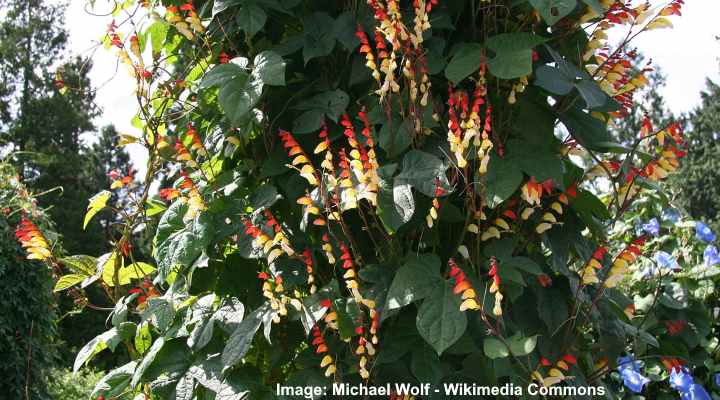
Firecracker vine is a stunning annual vining plant that adds a burst of yellow and red colors to landscapes during summer and fall. This vine features unique tubular flowers that are red and fade to orange, then yellow. The deeply lobed ovate leaves measure up to 6” (15 cm) long, and its flowers grow in clusters of 20 along the vine.
The firecracker climbing vine is also called the Spanish flag vine due to its red and yellow bloom color. This fast-growing twining vine is ideal for covering trellises, fences, or arbors in warm climates where it grows as a perennial vine. In temperate climates, you can plant the red and yellow-flowering vine as an annual or in containers.
- USDA Hardiness Zone: 9 to 11
- Light Exposure: Full sun
- Flowering Season: From summer through fall
- Size: 10 to 20 ft. (3 – 6 m) tall and up to 2 ft. (0.6 m) wide
- Soil and Water Requirements: Fertile, organically rich soil with good drainage
Yellow Trumpet Vine (Campsis radicans f. flava)

Yellow trumpet vine is a fast-growing climbing plant identified by its stunning bright yellow or pale orange trumpet-shaped flowers. The self-clinging woody climbing plant blooms in summer with clusters of tubular flowers contrasting with dark green leaves. The yellow flowers are followed by long, ornamental bean-like seed pods.
Yellow trumpet vine climbs and spreads vigorously, attaching itself to structures, trellises, and walls. It blooms during summer and is one of the most floriferous vines for warm climates. It’s heat, drought, and cold tolerant. But it can become invasive if left to grow freely.
The bright yellow or pale orange trumpet-shaped flowers of this vine are known to attract hummingbirds. Additionally, these colorful blossoms are likely to draw the attention of bees and butterflies, contributing to pollination in your garden.
- USDA Hardiness Zone: 5 to 9
- Light Exposure: Full sun or partial shade
- Flowering Season: Early to late summer
- Size: 20 to 40 ft. (6 – 12 m) tall and up to 10 ft. (3 m) wide.
- Soil and Water Requirements: Moist, well-drained soils
‘Golden Gate’ Climbing Rose (Rosa ‘Golden Gate’)

‘Golden Gate’ climbing rose is an attractive upright thorny climber with stunning large, double, golden-yellow flowers. The rose blooms appear in clusters throughout summer and fall. The yellow blooms have a strong, sweet, citrusy fragrance and grow 3.25” (8 cm) across, and its thorny stems grow up to 4 ft. (1.2 m) tall.
The yellow-flowering ‘Golden Gate’ climbing rose is a vigorous grower and repeat bloomer. This variety of vining rose performs well growing in full sun against a trellis, fence, or wall. Its yellow flowers also look spectacular over an arch, or arbor, or decorating an entranceway.
- USDA Hardiness Zone: 5 to 9
- Light Exposure: Full sun
- Flowering Season: Early summer through fall
- Size: Up to 8 ft. (2.4 m) tall and 3 to 4 ft. (1 – 1.2 m) wide
- Soil and Water Requirements: Moderately fertile, well-drained soil
Yellow Honeysuckle Vine (Lonicera flava)

Yellow honeysuckle is a deciduous climbing vine with trumpet-shaped tubular yellow or pale orange flowers. This twining vine has fragrant flowers 1.5” (4 cm) long, elliptic green leaves 3.5” (8 cm) long, and tendrils that attach to structures. The yellow or orange flowers give way to red berries in the fall.
Yellow honeysuckle is a vigorous climber and can reach heights of up to 20 feet (6 m). Landscape uses for this yellow-flowering vine include covering fences, decorating trellises, or scrambling over arbors. Left unsupported, the fast-growing vine is an ideal ground cover with yellow flowers for full sun.
Yellow honeysuckle vines thrive in well-drained soil with moderate water needs. Adding compost to the soil can improve its moisture retention capacity and supply essential nutrients for healthy growth and blooming.
- USDA Hardiness Zone: 5 to 8
- Light Exposure: Full sun or partial shade
- Flowering Season: Late spring and early summer
- Size: 10 to 20 ft. (6 m) tall and 3 to 6 ft. (1 – 1.8 m) wide
- Soil and Water Requirements: Well-drained soil, moderate water needs
Japanese Honeysuckle (Lonicera japonica ‘Halliana’)

Japanese honeysuckle ‘Halliana’ is a vigorous twining vine with fragrant pale yellow flowers in late spring through summer. The fast-growing climbing vine is characterized by its dark green leaves, twining stems, and clusters of showy white flowers that turn to pale yellow. These are followed by black berries. The popular vining plant can become invasive in some areas.
Japanese honeysuckle grows rapidly up to 30 ft. (9 m) tall. This versatile plant performs well when growing over fences, trellises, pergolas, or arbors. You can also grow it as a ground cover plant or in hanging baskets. This vine is low-maintenance and can tolerate a wide range of soil conditions.
- USDA Hardiness Zone: 4 to 9
- Light Exposure: Full sun or partial shade
- Flowering Season: Early spring through fall
- Size: 15 to 30 ft. (4.5 – 9 m) tall and 3 to 6 ft. (1 – 1.8 m) wide
- Soil and Water Requirements: Dry to moist well-drained soil
Canary Creeper (Senecio tamoides)

Canary creeper is a fast-growing climbing vine that produces clusters of bright yellow star-shaped flowers. This vine blooms in late summer and fall. Its rounded clusters of yellow flowers have a cinnamon aroma, contrasting with the deep green, heart-shaped, ivy-like leaves. In warmer climates, it’s a fast-growing evergreen vine.
The canary creeper is a versatile, cheerful plant that adds a splash of yellow colors to landscapes. The yellow vine’s twining growth and long stems make the plant ideal for climbing up trellises or fences. It also performs well in containers and hanging baskets.
- USDA Hardiness Zone: 9 to 11
- Light Exposure: Full sun or partial shade
- Flowering Season: Summer and fall
- Size: 6.6 to 13 ft. (2 – 4 m) tall, but sometimes as tall as 33 ft. (10 m)
- Soil and Water Requirements: Well-draining soil with high levels of organic matter
Yellow Nasturtium (Tropaeolum majus)
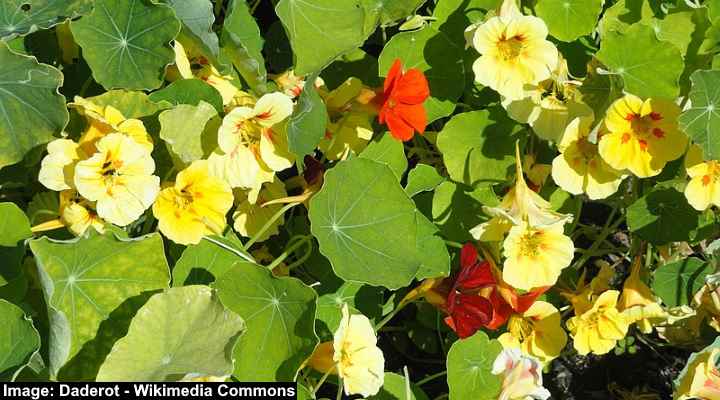
Yellow nasturtium is an easy-care creeping vine with funnel-shaped flowers and parasol-like green leaves. This sprawling vine blooms in many colors, including yellow. The highly fragrant yellow flowers can be single or double blooms and spread out along the ground on its sprawling stems.
Yellow nasturtium grows as a short-lived perennial vine or annual, depending on the climate. Landscaping ideas for this ground-hugging vine include edging, ground cover, or border planting. Climbing varieties are also perfect for covering fences and garden structures.
- USDA Hardiness Zone: 2 to 11
- Light Exposure: Full sun or partial shade
- Flowering Season: All summer and early fall
- Size: 1 to 10 ft. (0.3 – 3 m) tall and up to 3 feet (1 m) wide
- Soil and Water Requirements: low-fertile, well-drained soil for best flowering
Yellow Mandevilla (Pentalinon luteum)

Yellow mandevilla is a popular yellow-flowering vine with trumpet-shaped flowers. Popular in Florida, this scrambling woody vine blooms throughout the year in warm climates. Its large, funnel-like neon-yellow blossoms grow 4” (10 cm) in diameter and contrast with the glossy green leaves.
Yellow mandevilla is an ideal shrubby vine for climbing over fences, pergolas, and arbors, adding a pop of yellow colors to tropical landscapes. Its evergreen foliage is ideal for privacy, screening, or creating a vertical accent when supported against a trellis.
Yellow mandevilla vines can benefit from composting, as it enhances the overall soil structure, fertility, and water retention. This is especially important for a tropical vine that blooms throughout the year.
- USDA Hardiness Zone: 10 and 11
- Light Exposure: Full sun
- Flowering Season: Throughout the year
- Size: 6 to 13 ft. (1.8 – 4 m) tall
- Soil and Water Requirements: Fertile, loamy, well-draining soil
Butterfly Vine (Mascagnia macroptera or Callaeum macropterum)

Butterfly vine is a fast-growing evergreen vining plant with stunning orchid-like bright yellow flowers. Also called the orchid vine, this plant is famed for its cascading clusters of dainty yellow blooms, dark green foliage on twining stems, and papery seed pods resembling butterflies.
The tropical, versatile plant is popular in Texas and grows on trellises, fences, or as ground cover.
- USDA Hardiness Zone: 8 to 10
- Light Exposure: Full sun or partial sun
- Flowering Season: Repeat blooming from spring through fall
- Size: 10 to 15 ft. (3 – 4.5 m) tall with a similar spread if left unsupported
- Soil and Water Requirements: Well-drained soil
Golden Bells Clematis (Clematis tangutica)

Golden bells clematis is a vigorous climbing vine with eye-catching nodding golden yellow, bell-shaped flowers, followed by highly decorative fluffy seed heads. This vine has rapid growth, with lanceolate leaves growing on fuzzy stems. Thriving in full sun, the climber is ideal for vertical spaces, covering fences, or growing over an arbor.
While clematis, in general, prefers well-draining soil, composting can help improve the soil’s fertility and structure, supporting the golden bells clematis in producing its vibrant yellow, bell-shaped flowers.
This versatile scrambling vine performs well in sun or partial shade and tolerates drought. Its showy, tubular flowers attract hummingbirds and butterflies, making it a good addition to pollinator or butterfly gardens.
- USDA Hardiness Zone: 3 to 8
- Light Exposure: Full sun or partial shade
- Flowering Season: From summer through fall
- Size: 12 to 15 ft. (2.6 – 4.5 m) tall and 6 to 8 ft. (1.8 – 2.4 m) wide
- Soil and Water Requirements: Loamy, organically rich soil with good drainage soil
Cup of Gold Vine (Solandra maxima)

Cup of gold vine is a stunning tropical vine with large, golden-yellow bowl-shaped, showy flowers in summer. The eye-catching tropical flowers start light yellow and turn pale orange with prominent brown bands. The flowers also have five prominent stamens in the throat. The highly fragrant flowers exude a strong scent.
Also called Hawaiian lily, the fast-growing climbing vine has glossy, dark green leaves that provide a beautiful backdrop for the vibrant flowers. The huge yellow flowers measure 6” to 10” (15 – 25 cm) long and up to 6” (15 cm) wide. This ornamental vine is popular in tropical backyards to grow on trellises, cover fences, or create vertical gardens.
- USDA Hardiness Zone: 9 to 11
- Light Exposure: Full sun
- Flowering Season: Summer
- Size: Up to 20 ft. (6 m) tall and 40 ft. (12 m) wide
- Soil and Water Requirements: Humus-rich, slightly acidic, well-drained soil
Golden Yellow Cape Honeysuckle (Tecomaria capensis ‘Aurea’)

Golden yellow cape honeysuckle ‘Aurea’ is a beautiful yellow-flowering sprawling vine with clusters of fragrant flowers. This evergreen spreading plant is identified by golden yellow tubular, spring-blooming flowers that persist until fall. Additionally, it has pinnately compound, glossy green leaves, and is resistant to drought and full sunlight.
The golden-yellow cape honeysuckle is a fast-growing vine or rambling shrubby plant. It is easy to train its long stems to climb a trellis, arbor, or fence. Or you can prune into a compact ornamental shrub. Its long blooming time—year-long in warm climates—gives the yellow-flowering vine tremendous visual appeal.
This vine’s golden yellow tubular flowers can attract hummingbirds when in bloom. Additionally, these bright blossoms are likely to be visited by bees and butterflies, contributing to pollinator activity in your garden.
- USDA Hardiness Zone: 8 to 11
- Light Exposure: Full sun or semi-shade
- Flowering Season: Early spring to late fall
- Size: 5 to 8 ft. (1.5 – 2.4 m) tall and 10 to 15 ft. (3 – 4.5 m) wide
- Soil and Water Requirements: Well-drained soil and regular watering during summer
Yellow Bougainvillea Vine

Bougainvillea is one of the most spectacular tropical flowering vines you can grow in warm climates. The eye-catching flowers on this ornamental woody vine are colorful bracts or leaf-like structures. Other colors of bougainvillea include magenta, red, yellow, orange, white, or pink.
Bougainvillea vines blossom in full sun in zones 9 through 11. The large shrubby vines spread along walls, climb up trellises, and cover arbors. In some cases, you can train the flowering plants to grow in containers or use them as ground cover in full sun. In colder climates, you can grow bougainvillea in hanging baskets.
- USDA Hardiness Zone: 9 to 11
- Light Exposure: Full sun (6 or more hours of direct sunlight a day)
- Flowering Season: all year in tropical climates
- Size: 15 – 40 ft. (4.5 – 12 m) tall and wide
- Soil and Water Requirements: Loamy or sandy well-draining soil. Water more during warmer months. Bougainvilleas are drought-tolerant and require little water once established
Related articles:
